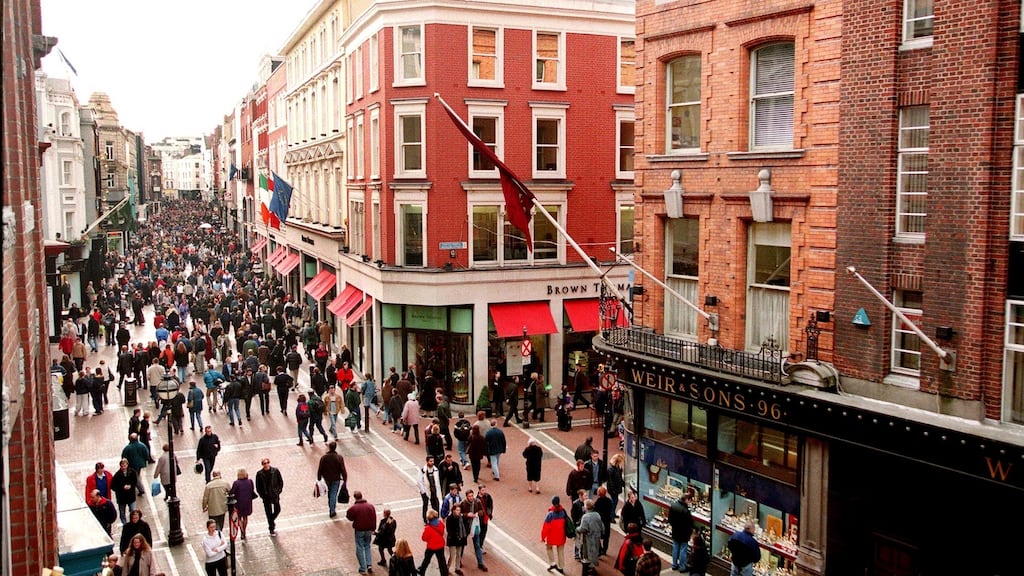Few streets in Ireland have changed as drastically as Grafton Street, Dublin, during the past 40 years. But what was once a street full of interesting locally owned shops has become an identikit Main Street, with some 40 multinational retailers, whose shops are replicated in similar main thoroughfares in numerous other countries.
I first got to know Grafton Street well in the mid- 1960s, when I worked for a publishing firm there. The street was chaotic, full of traffic fumes, as cars and double-decker buses hurtled down it from the direction of St Stephen’s Green.
Directly opposite the place where I worked was a branch of Liptons, a long-deceased supermarket chain, where I could buy food for my lunch.
Grafton Street is old, having been upgraded from a country lane in 1707.
It was created by Joshua Dawson, a developer and politician, who also created Dawson Street. Dawson named Grafton Street after Henry Fitzroy, the first Duke of Grafton.
In 1758, Whyte’s Academy was founded where Bewley’s, since 1927, is now trading. Whyte’s had the likes of Thomas Moore and the Duke of Wellington for pupils and kept going, in Grafton Street, until 1824.
Hodges Figgis, the renowned booksellers, had its beginnings in Grafton Street in 1797 and it remained there for just over a century.
Its shop at 104 Grafton Street was a great centre of knowledge in the city. In 1920, it moved to Nassau Street, stayed there for 25 years before moving again to its present location in Dawson Street.
Today, Dubray Books trades in Grafton Street.
Many other renowned firms had their origins in Grafton Street, such as Switzers department store, whose one-time premises are now occupied by Brown Thomas. Another noted firm, Weir’s the jewellers, at the corner of Grafton Street and Wicklow Street, has been there for 150 years.
As late as the 1980s, many of the shops in Grafton Street were locally owned, the likes of Louis Wine and his antiques shop, McConnell’s fish and poultry shop, the Eblana Bookshop, FX Kelly, the men’s outfitters, and Pia Bang, the women’s fashion shop.
Shree was an interesting Indian fashion shop at Number 87. Callaghans was a noted outfitters on the street.
Combridges fine art shop was a fixture for years on the street, before moving to South William Street, where it succumbed to the recession in 2012.
Reflecting one of the fads of the time, the street had two bakery shops producing hot bread.
Grafton Street even had a reading room for the Church of Christ, Scientist, as well as an Arab information centre.
Trading names for local shops were sometimes quirky, like the Lunatic Fringe ladies’ hairdressers.
The Peter Mark hairdressing salon at Number 74 is a rare surviving example of a shop that’s lasted in the street for well over 40 years.
Dunnes Stores has also survived in the street, as have the likes of Fox’s, the cigar merchants.
Thankfully, despite turbulent times and threats of closure over the past 15 years, Bewley’s has survived, its interior much refurbished, but its exterior untouched.
Grafton Street’s flower sellers have also managed to survive, adding bright splashes of colour, while a legion of street artists have continued to entertain the public. The Diceman was a regular on the street during the 1980s and into the early 1990s.
One intriguing survivor from that time is outside Captain America’s, happily still going strong. A small plaque notes that the Irish Writers’ Co- Operative was founded in that restaurant in 1975.
But the relentless takeover of the street by multinational retailers began in 1977, when McDonald’s took over what had been the old Mitchell’s café.
In 1988, Marks & Spencer began trading in Grafton Street. In 1998, Boots took over the old Dublin pharmacy chain of Hayes, Conyngham & Robinson.
As more and more multinational retailers crept in, other long-established trading names in Grafton Street gave up the ghost, following the Grafton cartoon and newsreel cinema , which closed in 1973. Woolworth’s, there since 1914, shut in 1984, as did West’s the jewellers in 2010, after 290 years.
Another casualty, five years ago, was Thomas Cook, the travel agents at Number 118, Lower Grafton Street.
Grafton Arcade and Creation Arcade, two retailing curiosities, were redeveloped out of existence.
One big positive change had come to Grafton Street in 1982, when traffic was finally banned in favour of pedestrians. At that stage, around 40, 000 pedestrians a day were using Grafton Street, long before it became a popular promenade for visiting tourists.
But one promise the old Dublin Corporation had given for Grafton Street in 1982 never materialised: a pedestrianised thoroughfare that was going to be lined with trees.
Back in the 1940s, after Leo Maguire had written a song called Dublin Saunter, first recorded by Noel Purcell, one line stuck in people’s minds: ”Grafton Street’s a wonderland” .
These days, as Grafton Street has become a relentless retailing hub for countless multinationals, I somehow doubt whether those words have much resonance today.









